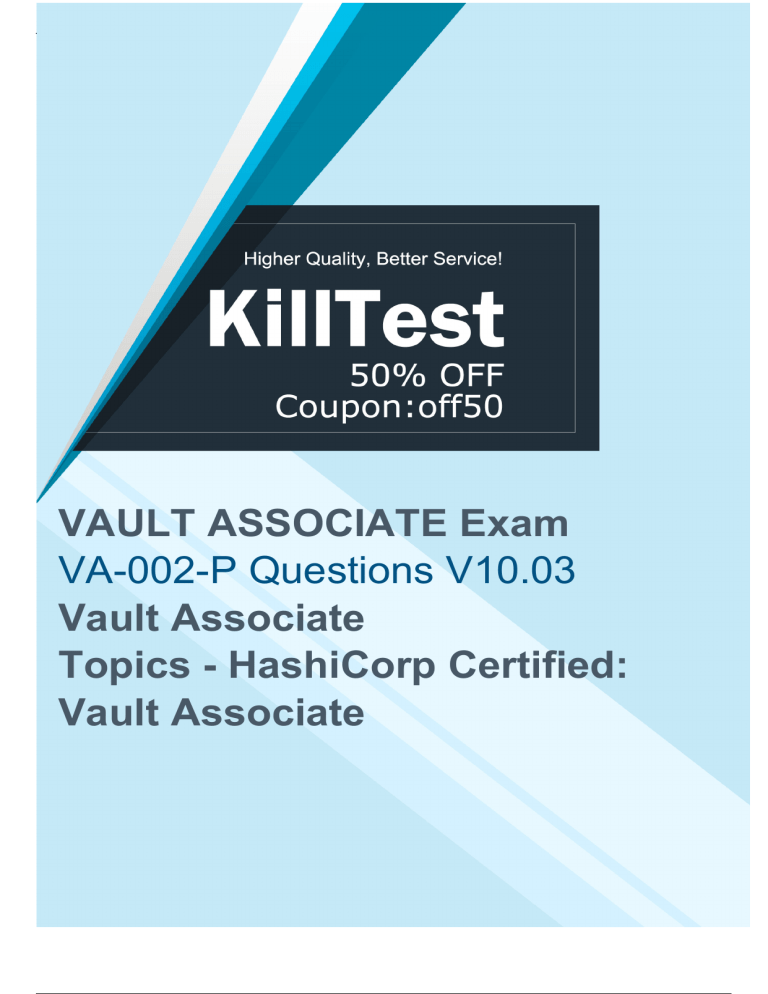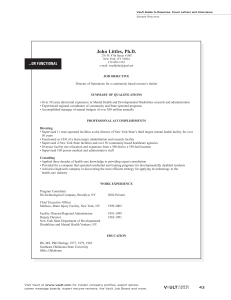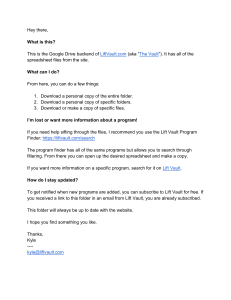HashiCorp VA-002-P Exam Questions (2024) - Explore a Free Demo of VA-002-P Materials
advertisement

VAULT ASSOCIATE Exam VA-002-P Questions V10.03 Vault Associate Topics - HashiCorp Certified: Vault Associate 1.You are using the Vault userpass auth method mounted at auth/userpass. How do you create a new user named "sally" with password "h0wN0wB4r0wnC0w"? This new user will need the power-users policy. A) a Fr e e D em o of V A -0 02 -P M at er ia ls B) 02 -P E xa m Q ue st io ns (2 02 4) -E xp lo re C) H as hi C or p V A -0 D) A. Option A B. Option B C. Option C D. Option D Answer: A Explanation: M at er ia ls When using Vault's userpass authentication method, you need to use the correct path and command to create a new user. In this case, the path is.auth/userpass/users/<username> Option A uses this path correctly, and also correctly sets the username to "sally", the password to "h0wN0wB4r0wnC0w", and gives the "power-users" policy. Option B uses the wrong path, which is not the correct command format to create the user.userpass/sally Option C tries to use the key-value store command, which is incorrect because we're creating a user, not a key-value pair.kv write The path for option D is also wrong, and it is missing the start command.vault put So, to create a new user named "sally" with a password of "h0wN0wB4r0wnC0w" and a "power-users" policy, you should use the command of option A. H as hi C or p V A -0 02 -P E xa m Q ue st io ns (2 02 4) -E xp lo re a Fr e e D em o of V A -0 02 -P 2.The vault lease renew command increments the lease time from: A. The current time B. The end of the lease Answer: A Explanation: The vault lease renew command increments the lease time from the current time, not the end of the lease. This means that the user can request a specific amount of time they want remaining on the lease, termed the increment. This is not an increment at the end of the current TTL; it is an increment from the current time. For example, vault lease renew -increment=3600 my-lease-id would request that the TTL of the lease be adjusted to 1 hour (3600 seconds) from now. Having the increment be rooted at the current time instead of the end of the lease makes it easy for users to reduce the length of leases if they don’t actually need credentials for the full possible lease period, allowing those credentials to expire sooner and resources to be cleaned up earlier. The requested increment is completely advisory. The backend in charge of the secret can choose to completely ignore it1. Reference: Lease, Renew, and Revoke | Vault | HashiCorp Developer 3.HOTSPOT Where do you define the Namespace to log into using the Vault Ul? To answer this question Use your mouse to click on the screenshot in the location described above. An arrow indicator will mark where you have clicked. Click the "Answer" button once you have positioned the arrow to answer the question. You may need to scroll down to see the entire screenshot. ia ls er M at -P 02 -0 A V of em o D e Fr e a re lo xp -E 4) 02 (2 ns io st ue Q m xa E 02 -P -0 A V p or C hi as H Answer: The namespace can be defined in the “Mount path” field in the “Advanced options” section of the login screen. The mount path is the path where the auth method is enabled, and it can include a namespace prefix. For example, if the LDAP auth method is enabled at the path ns1/auth/ldap, where ns1 is the namespace, then the mount path field should be set to ns1/auth/ldap. This way, the Vault UI will log in to the correct namespace and auth method. Alternatively, the namespace can also be specified in the URL of the Vault UI, such as https://vault.example.com/ui/vault/auth/ns1/auth/ldap/login. V A -0 02 -P E xa m Q ue st io ns (2 02 4) -E xp lo re a Fr e e D em o of V A -0 02 -P M at er ia ls 4.You have a 2GB Base64 binary large object (blob) that needs to be encrypted. Which of the following best describes the transit secrets engine? A. A data key encrypts the blob locally, and the same key decrypts the blob locally. B. To process such a large blob. Vault will temporarily store it in the storage backend. C. Vault will store the blob permanently. Be sure to run Vault on a compute optimized machine D. The transit engine is not a good solution for binaries of this size. Answer: D Explanation: The transit secrets engine is not a good solution for binaries of this size, because it is designed to handle cryptographic functions on data in-transit, not data at-rest. The transit secrets engine does not store any data sent to it, so it would require sending the entire 2GB blob to Vault for encryption or decryption, which would be inefficient and impractical. A better solution would be to use the transit secrets engine to generate a data key, which is a high-entropy key that can be used to encrypt or decrypt data locally. The data key can be returned in plaintext or wrapped by another key, depending on the use case. This way, the transit secrets engine only handles the encryption or decryption of the data key, not the data itself, and the data can be stored in any primary data store. Reference: Transit - Secrets Engines | Vault | HashiCorp Developer, Encryption as a service: transit secrets engine | Vault | HashiCorp Developer H as hi C or p 5.How would you describe the value of using the Vault transit secrets engine? A. Vault has an API that can be programmatically consumed by applications B. The transit secrets engine ensures encryption in-transit and at-rest is enforced enterprise wide C. Encryption for application data is best handled by a storage system or database engine, while storing encryption keys in Vault D. The transit secrets engine relieves the burden of proper encryption/decryption from application developers and pushes the burden onto the operators of Vault Answer: D Explanation: The transit secrets engine relieves the burden of proper encryption/decryption from application developers and pushes the burden onto the operators of Vault. The transit secrets engine provides encryption as a service, which means that it performs cryptographic operations on data in-transit without storing any data. This allows developers to delegate the responsibility of managing encryption keys and algorithms to Vault operators, who can define and enforce policies on the transit secrets engine. This way, developers can focus on their application logic and data, while Vault handles the encryption and decryption of data in a secure and scalable manner. Reference: Transit - Secrets Engines | Vault | HashiCorp Developer, Encryption as a service: transit secrets engine | Vault | HashiCorp Developer xa m Q ue st io ns (2 02 4) -E xp lo re a Fr e e D em o of V A -0 02 -P M at er ia ls 6.What is the Vault CLI command to query information about the token the client is currently using? A. vault lookup token B. vault token lookup C. vault lookup self D. vault self-lookup Answer: B Explanation: The Vault CLI command to query information about the token the client is currently using is vault token lookup. This command displays information about the token or accessor provided as an argument, or the locally authenticated token if no argument is given. The information includes the token ID, accessor, policies, TTL, creation time, and metadata. This command can be useful for debugging and auditing purposes, as well as for renewing or revoking tokens. Reference: token lookup - Command | Vault | HashiCorp Developer, Tokens | Vault | HashiCorp Developer H as hi C or p V A -0 02 -P E 7.Which of the following is a machine-oriented Vault authentication backend? A. Okta B. AppRole C. Transit D. GitHub Answer: B Explanation: AppRole is a machine-oriented authentication method that allows machines or applications to authenticate with Vault using a role ID and a secret ID. The role ID is a unique identifier for the application, and the secret ID is a single-use credential that can be delivered to the application securely. AppRole is designed to provide secure introduction of machines and applications to Vault, and to support the principle of least privilege by allowing fine-grained access control policies to be attached to each role1. Okta, GitHub, and Transit are not machine-oriented authentication methods. Okta and GitHub are user-oriented authentication methods that allow users to authenticate with Vault using their Okta or GitHub credentials23. Transit is not an authentication method at all, but a secrets engine that provides encryption as a service4. Reference: AppRole Auth Method | Vault | HashiCorp Developer Okta Auth Method | Vault | HashiCorp Developer GitHub Auth Method | Vault | HashiCorp Developer Transit Secrets Engine | Vault | HashiCorp Developer H as hi C or p V A -0 02 -P E xa m Q ue st io ns (2 02 4) -E xp lo re a Fr e e D em o of V A -0 02 -P M at er ia ls 8.Security requirements demand that no secrets appear in the shell history. Which command does not meet this requirement? A. generate-password | vault kv put secret/password value B. vault kv put secret/password value-itsasecret C. vault kv put secret/password value=@data.txt D. vault kv put secret/password value-SSECRET_VALUE Answer: B Explanation: The command that does not meet the security requirement of not having secrets appear in the shell history is B. vault kv put secret/password value-itsasecret. This command would store the secret value “itsasecret” in the key/value secrets engine at the path secret/password, but it would also expose the secret value in the shell history, which could be accessed by other users or malicious actors. This is not a secure way of storing secrets in Vault. The other commands are more secure ways of storing secrets in Vault without revealing them in the shell history. A. generate-password | vault kv put secret/password value would use a pipe to pass the output of the generate-password command, which could be a script or a tool that generates a random password, to the vault kv put command, which would store the password in the key/value secrets engine at the path secret/password. The password would not be visible in the shell history, only the commands. C. vault kv put secret/password value=@data.txt would use the @ syntax to read the secret value from a file named data.txt, which could be encrypted or protected by file permissions, and store it in the key/value secrets engine at the path secret/password. The file name would be visible in the shell history, but not the secret value. D. vault kv put secret/password valueSSECRET_VALUE would use the -S syntax to read the secret value from the environment variable SECRET_VALUE, which could be set and unset in the shell session, and store it in the key/value secrets engine at the path secret/password. The environment variable name would be visible in the shell history, but not the secret value. Reference: [Write Secrets | Vault | HashiCorp Developer] (2 02 4) -E xp lo re a Fr e e D em o of V A -0 02 -P M at er ia ls 9.You can build a high availability Vault cluster with any storage backend. A. True B. False Answer: B Explanation: Not all storage backends support high availability mode for Vault. Only the storage backends that support locking can enable Vault to run in a multi-server mode where one server is active and the others are standby. Some examples of storage backends that support high availability mode are Consul, Integrated Storage, and ZooKeeper. Some examples of storage backends that do not support high availability mode are Filesystem, MySQL, and PostgreSQL. Reference: https://developer.hashicorp.com/vault/docs/concepts/ha1, https://developer.hashicorp.com/vault/docs/configuration/storage2 H as hi C or p V A -0 02 -P E xa m Q ue st io ns 10.What command creates a secret with the key "my-password" and the value "53cr3t" at path "my-secrets" within the KV secrets engine mounted at "secret"? A. vault kv put secret/my-secrets/my-password 53cr3t B. vault kv write secret/my-secrets/my-password 53cr3t C. vault kv write 53cr3t my-secrets/my-password D. vault kv put secret/my-secrets »y-password-53cr3t Answer: A Explanation: The vault kv put command writes the data to the given path in the K/V secrets engine. The command requires the mount path of the K/V secrets engine, the secret path, and the key-value pair to store. The mount path can be specified with the -mount flag or as part of the secret path. The key-value pair can be given as an argument or read from a file or stdin. The correct syntax for the command is: vault kv put -mount=secret my-secrets/my-password 53cr3t or vault kv put secret/my-secrets my-password=53cr3t The other options are incorrect because they use the deprecated vault kv write command, or they have the wrong order or format of the arguments. Reference: https://developer.hashicorp.com/vault/docs/commands/kv/put3, https://developer.hashicorp.com/vault/docs/commands/kv4 -E xp lo re a Fr e e D em o of V A -0 02 -P M at er ia ls 11.What can be used to limit the scope of a credential breach? A. Storage of secrets in a distributed ledger B. Enable audit logging C. Use of a short-lived dynamic secrets D. Sharing credentials between applications Answer: C Explanation: Using a short-lived dynamic secrets can help limit the scope of a credential breach by reducing the exposure time of the secrets. Dynamic secrets are generated on-demand by Vault and automatically revoked when they are no longer needed. This way, the credentials are not stored in plain text or in a static database, and they can be rotated frequently to prevent unauthorized access. Dynamic secrets also provide encryption as a service, which means that they perform cryptographic operations on data in-transit without storing any data. This adds an extra layer of security and reduces the risk of data leakage or tampering. Reference: Dynamic secrets | Vault | HashiCorp Developer, What are dynamic secrets and why do I need them? - HashiCorp H as hi C or p V A -0 02 -P E xa m Q ue st io ns (2 02 4) 12.What environment variable overrides the CLI's default Vault server address? A. VAULT_ADDR B. VAULT_HTTP_ADORESS C. VAULT_ADDRESS D. VAULT _HTTPS_ ADDRESS Answer: A Explanation: Option A. VAULT_ADDR is an environment variable that overrides the CLI's default Vault server address. This environment variable can be set to the URL of the Vault server, which is used by Vault's CLI tool to communicate with the Vault server. 13.Which of the following statements describe the CLI command below? S vault login -method-1dap username-mitche11h A. Generates a token which is response wrapped B. You will be prompted to enter the password C. By default the generated token is valid for 24 hours D. Fails because the password is not provided Answer: B Explanation: This command is a command to log in to Vault using the LDAP method. Usually, after executing this command, the user is prompted to enter their password, rather than the command immediately failing because the password was not provided.vault login -method=ldap username=mitchellh H as hi C or p V A -0 02 -P E xa m Q ue st io ns (2 02 4) -E xp lo re a Fr e e D em o of V A -0 02 -P M at er ia ls 14.The following three policies exist in Vault. What do these policies allow an organization to do? A. Separates permissions allowed on actions associated with the transit secret engine B. Nothing, as the minimum permissions to perform useful tasks are not present C. Encrypt, decrypt, and rewrap data using the transit engine all in one policy e D em o of V A -0 02 -P M at er ia ls D. Create a transit encryption key for encrypting, decrypting, and rewrapping encrypted data Answer: A Explanation: These policies allow organizations to: Separates permissions allowed on actions associated with the transit secret engine Here's how to do it: app.hcl The policy allows the entity to perform cryptographic operations using a specific key () of the Transit secret engine.my_app_key callcenter.hcl The policy allows decryption operations to be performed on the same.my_app_key rewrap.hcl Policies allow the key to be read and the data to be reencapsulated, which essentially decrypts and re-encrypts the data without displaying plaintext, which is useful for rotating the underlying encryption key. Each policy targets specific operations of the Transit secret engine, enabling finegrained access control to encryption, decryption, and key management functions. This is important for maintaining a strict separation of duties within the organization. H as hi C or p V A -0 02 -P E xa m Q ue st io ns (2 02 4) -E xp lo re a Fr e 15.Your DevOps team would like to provision VMs in GCP via a CICD pipeline. They would like to integrate Vault to protect the credentials used by the tool. Which secrets engine would you recommend? A. Google Cloud Secrets Engine B. Identity secrets engine C. Key/Value secrets engine version 2 D. SSH secrets engine Answer: A Explanation: The Google Cloud Secrets Engine is the best option for the DevOps team to provision VMs in GCP via a CICD pipeline and integrate Vault to protect the credentials used by the tool. The Google Cloud Secrets Engine can dynamically generate GCP service account keys or OAuth tokens based on IAM policies, which can be used to authenticate and authorize the CICD tool to access GCP resources. The credentials are automatically revoked when they are no longer used or when the lease expires, ensuring that the credentials are short-lived and secure. The DevOps team can configure rolesets or static accounts in Vault to define the scope and permissions of the credentials, and use the Vault API or CLI to request credentials on demand. The Google Cloud Secrets Engine also supports generating access tokens for impersonated service accounts, which can be useful for delegating access to other service accounts without storing or managing their keys1. The Identity Secrets Engine is not a good option for this use case, because it does not generate GCP credentials, but rather generates identity tokens that can be used to access other Vault secrets engines or namespaces2. The Key/Value Secrets Engine version 2 is also not a good option, because it does not generate dynamic credentials, but rather stores and manages static secrets that the user provides3. The SSH Secrets Engine is not a good option either, because it does not generate GCP credentials, but rather generates SSH keys or OTPs that can be used to access remote hosts via SSH4. Reference: Google Cloud - Secrets Engines | Vault | HashiCorp Developer Identity Secrets Engines | Vault | HashiCorp Developer KV - Secrets Engines | Vault | HashiCorp Developer SSH - Secrets Engines | Vault | HashiCorp Developer H as hi C or p V A -0 02 -P E xa m Q ue st io ns (2 02 4) -E xp lo re a Fr e e D em o of V A -0 02 -P M at er ia ls 16.Which of these is not a benefit of dynamic secrets? A. Supports systems which do not natively provide a method of expiring credentials B. Minimizes damage of credentials leaking C. Ensures that administrators can see every password used D. Replaces cumbersome password rotation tools and practices Answer: C Explanation: Dynamic secrets are generated on-demand by Vault and have a limited time-to-live (TTL). They do not ensure that administrators can see every password used, as they are often encrypted and ephemeral. The benefits of dynamic secrets are: They support systems that do not natively provide a method of expiring credentials, such as databases, cloud providers, SSH, etc. Vault can revoke the credentials when they are no longer needed or when the lease expires. They minimize the damage of credentials leaking, as they are short-lived and can be easily rotated or revoked. If a credential is compromised, the attacker has a limited window of opportunity to use it before it becomes invalid. They replace cumbersome password rotation tools and practices, as Vault can handle the generation and revocation of credentials automatically and securely. This reduces the operational overhead and complexity of managing secrets. Reference: https://developer.hashicorp.com/vault/tutorials/getting-started/getting-started-dynamicsecrets1, https://developer.hashicorp.com/vault/docs/concepts/lease2 17.Which of the following cannot define the maximum time-to-live (TTL) for a token? A. By the authentication method t natively provide a method of expiring credentials B. By the client system f credentials leaking C. By the mount endpoint configuration very password used D. A parent token TTL e password rotation tools and practices E. System max TTL Answer: B 02 -P E xa m Q ue st io ns (2 02 4) -E xp lo re a Fr e e D em o of V A -0 02 -P M at er ia ls Explanation: The maximum time-to-live (TTL) for a token is defined by the lowest value among the following factors: The authentication method that issued the token. Each auth method can have a default and a maximum TTL for the tokens it generates. These values can be configured by the auth method’s mount options or by the auth method’s specific endpoints. The mount endpoint configuration that the token is accessing. Each secrets engine can have a default and a maximum TTL for the leases it grants. These values can be configured by the secrets engine’s mount options or by the secrets engine’s specific endpoints. A parent token TTL. If a token is created by another token, it inherits the remaining TTL of its parent token, unless the parent token has an infinite TTL (such as the root token). A child token cannot outlive its parent token. System max TTL. This is a global limit for all tokens and leases in Vault. It can be configured by the system backend’s max_lease_ttl option. The client system that uses the token cannot define the maximum TTL for the token, as this is determined by Vault’s configuration and policies. The client system can only request a specific TTL for the token, but this request is subject to the limits imposed by the factors above. Reference: https://developer.hashicorp.com/vault/docs/concepts/tokens3, https://developer.hashicorp.com/vault/docs/concepts/lease2, https://developer.hashicorp.com/vault/docs/commands/auth/tune4, https://developer.hashicorp.com/vault/docs/commands/secrets/tune5, https://developer.hashicorp.com/vault/docs/commands/token/create6 H as hi C or p V A -0 18.What are orphan tokens? A. Orphan tokens are tokens with a use limit so you can set the number of uses when you create them B. Orphan tokens are not children of their parent; therefore, orphan tokens do not expire when their parent does C. Orphan tokens are tokens with no policies attached D. Orphan tokens do not expire when their own max TTL is reached Answer: B Explanation: An orphan token is a token that cannot be cascaded to be revoked when its parent token is revoked. Typically, when a parent token is revoked, all child tokens created by it are also revoked. However, orphan tokens are an exception, as they do not have this parent-child association and therefore remain active when the parent token is revoked. -P M at er ia ls 19.To give a role the ability to display or output all of the end points under the /secrets/apps/* end point it would need to have which capability set? A. update B. read C. sudo D. list E. None of the above Answer: D Explanation: In Vault, permission is required to view or output all endpoints under a path. The permission allows the role to view all key names under the path, but does not provide the content of the key. “list” E xa m Q ue st io ns (2 02 4) -E xp lo re a Fr e e D em o of V A -0 02 20.You have been tasked with writing a policy that will allow read permissions for all secrets at path secret/bar. The users that are assigned this policy should also be able to list the secrets. What should this policy look like? A) H as hi C or p V A -0 02 -P B) C) ia ls xp lo re a Fr e e D em o of V A -0 02 -P M at er D) H as hi C or p V A -0 02 -P E xa m Q ue st io ns (2 02 4) -E A. Option A B. Option B C. Option C D. Option D Answer: A Explanation: This policy will allow the user to read all the secrets in the read path and list all the secrets in that path. The asterisk (*) here is a wildcard that indicates all possible subpaths under the path. Such a policy setup ensures that the user can not only list all the secrets, but also read each one. secret/bar/* Get full version of VA-002-P Q&As Powered by TCPDF (www.tcpdf.org)



